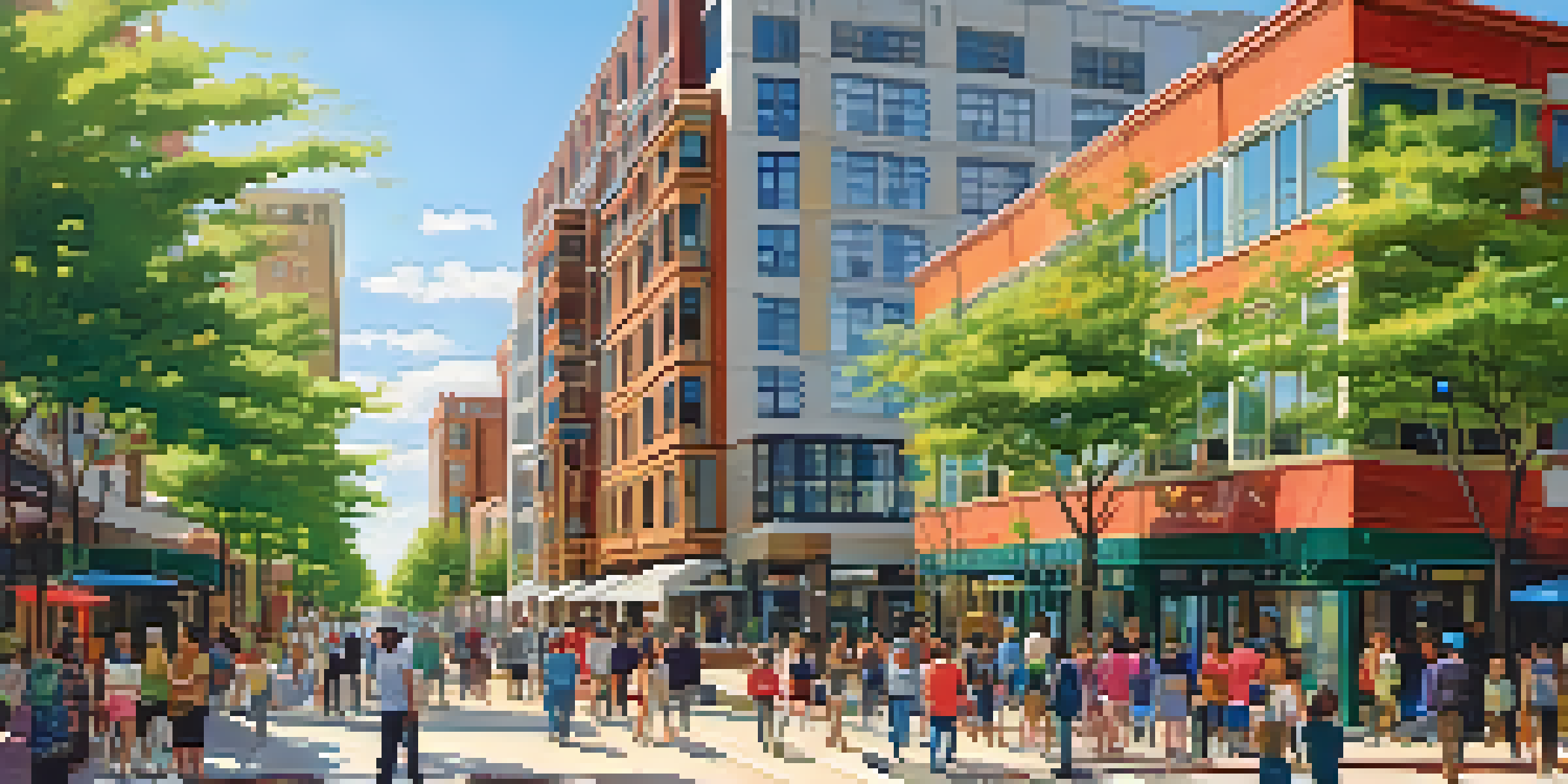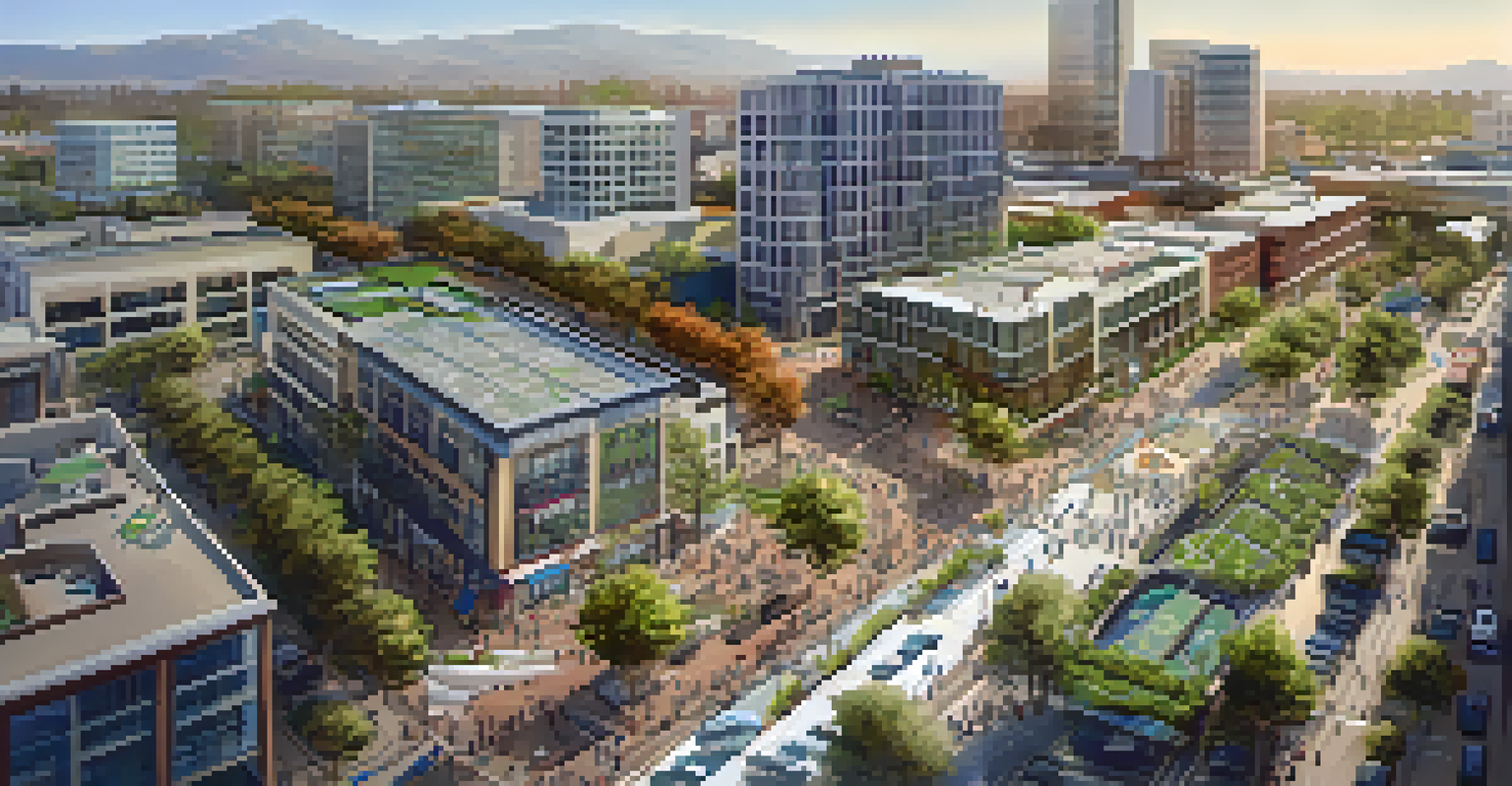Evaluating the Role of Transit-Oriented Development in San Jose

Understanding Transit-Oriented Development (TOD)
Transit-Oriented Development (TOD) refers to a type of urban development that focuses on maximizing access to public transport. By concentrating housing, jobs, and amenities around transit hubs, TOD encourages a lifestyle that relies less on personal vehicles. This approach not only helps reduce traffic congestion but also promotes a more sustainable environment.
A city is not an accident but the result of coherent visions and choices.
In essence, TOD aims to create walkable neighborhoods where residents can easily access public transit, making daily commutes more efficient. You can think of it as creating a vibrant ecosystem where homes, offices, and shops coexist in harmony, all within a short walk from a train or bus station. This kind of planning can significantly enhance the quality of life for residents.
As cities grow, the need for effective transportation solutions becomes more pressing. In San Jose, adopting TOD principles is essential for accommodating the rising population while minimizing the ecological footprint. This development strategy is not just about building more homes; it’s about creating communities that thrive on connectivity and accessibility.
The Current Transit Landscape in San Jose
San Jose, being a pivotal city in Silicon Valley, faces unique transportation challenges. With a population exceeding a million, the city grapples with heavy traffic congestion and limited public transit options. However, the ongoing development of light rail and bus rapid transit lines presents an opportunity to reshape this landscape.

The VTA (Valley Transportation Authority) operates several transit lines, but many residents still rely on cars for daily commuting. Unfortunately, this reliance can lead to increased air pollution and longer commute times. Therefore, integrating TOD strategies could significantly improve public transit usage and reduce the number of cars on the road.
TOD Promotes Sustainable Living
Transit-Oriented Development encourages a lifestyle that relies less on personal vehicles, enhancing accessibility and reducing environmental impact.
Moreover, as new transit lines are introduced, it becomes essential to ensure that surrounding areas are developed with TOD principles in mind. This means creating mixed-use developments that encourage walking and cycling, making public transport a more attractive option for residents.
Benefits of Transit-Oriented Development
The benefits of Transit-Oriented Development extend far beyond just improved transportation. One of the most significant advantages is the creation of vibrant, mixed-use communities that foster social interaction. When people can walk to shops, parks, and restaurants, it enhances their overall quality of life and strengthens community ties.
Transit-oriented development is the key to sustainable urban growth, creating communities that prioritize people over cars.
Additionally, TOD can lead to economic growth by attracting businesses that want to be near transit hubs. For instance, a coffee shop or a grocery store near a busy train station can thrive due to high foot traffic. This not only boosts the local economy but also creates jobs, contributing to a more robust community.
Furthermore, TOD promotes environmental sustainability by encouraging the use of public transit, which reduces greenhouse gas emissions. By creating spaces that prioritize walking and biking, we can move towards a healthier planet, making TOD not just a planning strategy but a crucial step in combating climate change.
Challenges Facing Transit-Oriented Development
Despite the advantages, implementing Transit-Oriented Development is not without its challenges. One significant hurdle is the need for coordinated planning among various stakeholders, including city officials, developers, and community members. Each group often has different priorities, making consensus a tough nut to crack.
Another challenge lies in the financing of TOD projects. Developing near transit hubs can require substantial investment, and securing funding can be a daunting task. Without adequate financial resources, even the best-planned projects may not come to fruition, leaving communities without the benefits of TOD.
Community Input is Crucial
Engaging residents in the planning process ensures that developments reflect the community’s needs and fosters trust between developers and the public.
Additionally, there’s the risk of gentrification. As neighborhoods near transit stations become more desirable, property values may rise, potentially displacing long-time residents. It’s crucial to create policies that balance development with the needs of existing community members, ensuring that everyone can benefit from this transformation.
Case Studies of Successful TOD in San Jose
Looking at successful examples of Transit-Oriented Development can provide valuable insights for San Jose. One notable case is the Diridon Station area, which is being transformed into a vibrant hub for transit, including high-speed rail and light rail connections. This redevelopment aims to create a lively community with housing, offices, and public spaces—all within walking distance of transit.
Another example is the San Jose Downtown area, which has seen the rise of mixed-use developments that incorporate residential units, retail, and office spaces. These projects not only support public transit but also contribute to the city's economic vitality by attracting new businesses and residents.
These cases demonstrate that, when done right, TOD can create thriving neighborhoods that enhance accessibility and sustainability. They serve as models for future projects in San Jose, showcasing the potential for growth while maintaining the city's unique character.
Community Involvement in TOD Planning
Community involvement is crucial to the success of Transit-Oriented Development projects. Engaging residents in the planning process ensures that their needs and concerns are addressed, leading to developments that truly reflect the community’s desires. Public forums, surveys, and workshops can provide valuable feedback and foster a sense of ownership among residents.
When community members are actively involved, it also helps to build trust between developers and the public. Transparency in communication can alleviate fears about displacement and gentrification, encouraging support for new projects. In San Jose, fostering this collaboration can be the key to unlocking the full potential of TOD.
San Jose's Future with TOD Looks Bright
With advancements in public transit, San Jose has the opportunity to create a connected and inclusive urban environment that benefits all residents.
Moreover, community input can lead to innovative solutions that may not have been considered otherwise. Local insights can help identify specific amenities or services that residents value, ensuring that new developments enhance the neighborhood rather than disrupt it. Ultimately, successful TOD planning hinges on a strong partnership between developers and the community.
The Future of Transit-Oriented Development in San Jose
As San Jose continues to grow, the future of Transit-Oriented Development looks promising. With ongoing advancements in public transit infrastructure, there’s a unique opportunity to reshape the city’s urban landscape. By prioritizing TOD, San Jose can create a more connected and sustainable environment for its residents.
Looking ahead, the key will be to balance development with social equity, ensuring that all community members benefit from these changes. This will require thoughtful planning and a commitment to inclusivity, making sure that existing residents are not pushed out as new developments arise.

In conclusion, as San Jose embraces Transit-Oriented Development, it has the potential to set a standard for urban planning across the nation. By focusing on sustainability, accessibility, and community involvement, the city can create a vibrant future that meets the needs of its growing population while preserving its unique character.